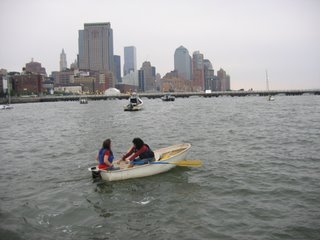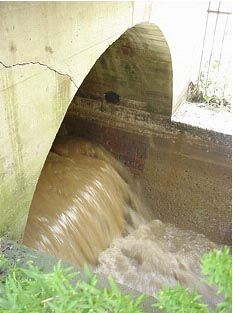Turning the Tide into Megawatts
 Our Town downtown
Our Town downtownOctober 23, 2006
An ever-renewable resource is about to be tapped
One day in the not-so-far future when you boot up your computer, its screen may be brightened by power that comes from one of the darkest places in this city: the murky, mucky bed of the East River.
High tide in the East River, a channel between the Long Island Sound and the Atlantic Ocean, is particularly strong, reaching over five knots or almost six miles per hour, according to the National Oceanic and Atmospheric Administration. It’s said that if you jump in you’ll be at the Statue of Liberty in no time. Last week, the drowned body of a 16-year-old boy who went into the water near Pike Slip was found near Pier 17.
Verdant Power is determined to tap into that force by installing an approximately 37-acre field of turbines between Roosevelt Island and Queens that will extend from the Roosevelt Island Bridge to the northern tip of Roosevelt Island. The field will have three to four hundred turbines and will generate 10 megawatts, enough to power about 8,000 homes.
The 16-foot diameter turbines, which look like underwater windmills, will be bolted to steel pipes filled with mortar and socketed to rock in the riverbed, and will swivel with the tide. Each turbine will have three blades which will rotate at the speed of the water, between 32 and 35 revolutions per minute, which the company claims is slow enough to avoid harming fish passing through the turbine field.
Fish safety has been the subject of a three-year discussion between Verdant Power, the New York State Department of Environmental Conservation, and a handful of local environmental groups. The result of the back-and-forth is that Verdant Power has just finished installing two million dollars’ worth of fish surveillance equipment in the river.
Because the water is extremely cloudy, two different fish monitoring systems will be used in lieu of cameras: hydroacoustic transducers, which uses the echoes from when fish swim through an acoustic beam, and a high-definition sonar system called Didson, used specifically to observe and count fish in turbid conditions.
“We think it’s overkill,” said Trey Taylor, president of Verdant Power, but “we’re anxious to get this right.” Taylor believes that the surveillance equipment will provide empirical evidence that the slow-moving, blunt-edged turbines do no harm to the fish or the environment. If that can be proven, it will pave the way not only for the Roosevelt Island Tidal Energy project, but for four or five other potential sites in the tri-state area as well.
The going is slow because this field of free-flow turbines is the first of its kind. Similar systems from England to Scotland have relied on one massive energy-generating unit or a dam.
In 2003 Verdant Power tested a single turbine, suspended in the East River from a barge, for about five weeks. Its next step is to install six more – first two, then an additional four. Because the project is experimental, the company was granted permission to install its “six-pack” without obtaining a full hydropower license, but it will have to apply for a license based on data collected from the six-pack before going ahead with the full turbine field.
Drilling is scheduled to begin next week, and the first two turbines should be installed the week of November 6. Once the state Department of Environmental Conservation gives the thumbs up, another four turbines will go in, completing the “six-pack.”
Verdant Power seems to be good at making partners of potential adversaries. The company gave Riverkeeper access to its state-of-the-art equipment and asked the group to help monitor fish traffic. Riverkeeper was one of four environmental groups that said the company had not done enough research assessing the project’s environmental impact.
Verdant Power is also in close communication with Con Edison, because the six-pack will be supplying power to two Con Ed customers: a Gristedes supermarket and the Motorgate Parking Garage, both located on Roosevelt Island near the on-shore control room connected to the six-pack via cables.
When the tide gets strong, Verdant Power will take over from Con Ed as power supplier to the garage and grocery store. The companies will use computerized communications to transition seamlessly. “You won’t even see the lights flicker,” says Taylor.
Roosevelt Island maintenance workers park and plug in their battery-powered golf cart-like vehicles in the Motorgate garage. Taylor seems tickled to point out that an emissions-free power source will be charging emissions-free vehicles.
Verdant Power has spent $3 million to date on this project, and the New York State Energy Research and Development Authority has kicked in $2 million. The final price tag will probably be around $20 million, says Taylor, and the date of completion, 2008.
The next step for Verdant Power is to get costs down from well over $4000 per kilowatt to between $2000 and $2500 per kilowatt “from water to wire.”
One priceless advantage of locally-produced power is that it doesn’t have to go through the overloaded power grid, which is susceptible to blackouts and terrorist attacks. The state requires that eighty percent of the city’s forecasted peak load be home-grown. In 2003, a task force of power companies and government agencies projected that in order to meet that requirement, the city would need to generate 3780 more kilowatts by 2008. The turbine field will produce ten thousand kilowatts.
“During the next blackout,” says Taylor, “Roosevelt Island will be all lit up.”
--By Becca Tucker


